How biologically-important chemicals often got discovered (auxin and serotonin, for example).
Charles Darwin experimented on elongation and bending of plant seedlings; & hypothesized that some chemical gets produced at shoot tips, gets pumped downward, and stimulates elongation of cells in plant stems.
In the 1930s, a Dutchman named Went developed methods for comparing amounts of Darwin's hypothetical chemical, one of which is shown in the following diagram. This is a bioassay.

Extracts of plant tissues were fractionated, and compared using this assay. Eventually, pure chemicals were isolated (by Kenneth Thimann) that produce strong elongation effects.
Also in the 1930s & 40s, there was evidence that some chemical in blood serum stimulates smooth muscle contraction.
Please invent a bioassay by which this hypothetical chemical could have been identified. (Guess why it was named "serotonin"?)
Because it is in serum and stimulates muscle "tone" (=long term contraction)
Serotonin also turns out to be an important neurotransmitter.
Prozac selectively inhibits re-uptake of serotonin. LSD acts on serotonin receptors.
Notice the analogy between 2, 4-D versus LSD and Prozac.
Spemann's hypothetical inducing substance was sought using bioassays.
Guess why that approach failed.
Because salami can induce second embryos; The effect isn't specific enough.
Please invent a bioassay for auxin based on its stimulation of root formation.
THE POWER OF MOVEMENT IN PLANTS.
BY CHARLES DARWIN, LL.D., F.R.S.
ASSISTED BY FRANCIS DARWIN.
CONTENTS
INTRODUCTION...Page 1-9. CHAPTER I.
THE CIRCUMNUTATING MOVEMENTS OF SEEDLING PLANTS